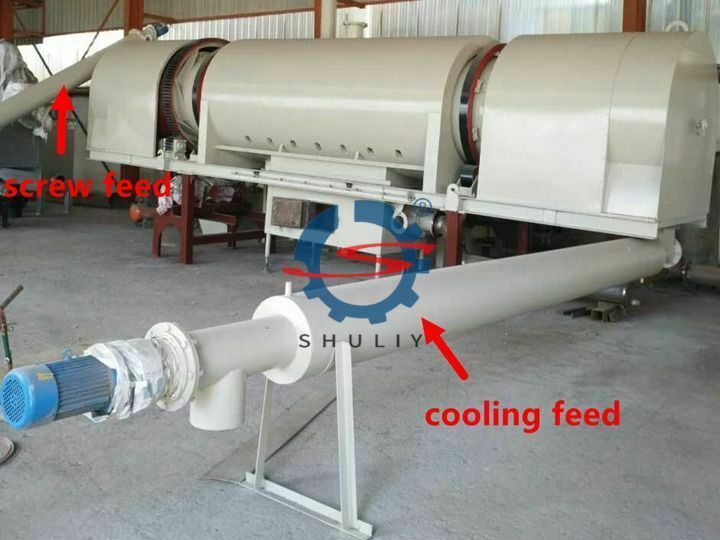ロータリー炭化炉 |ココナッツ炭製造機
| モデル | SL-CF800 |
| 直径(mm) | 800 |
| 能力(kg/h) | 400-600 |
| 主電力(kw) | 18.5 |
| 炭化温度(℃) | 500-800 |
| ファン出力(kw) | 5.5 |
回転炭化炉は、高度自動化された炭製造装置です。その炭化原料は非常に多様で、ほとんどが農林廃棄物、果物の殻、工業廃材です。ピーナッツ殻炭、米殻炭、竹くず炭、ココナッツ殻炭、アプリコット殻炭、コーヒーかす炭などです。これらは炭化メカニズムを通じて製造されます。連続炭化炉で生成される炭材料は、クリーンで無毒、無煙であり、良好な塑性を持っています。要するに、回転炭化炉の市場展望は広いです。迅速にご連絡いただき、製品価格、カテゴリ、および出荷情報を入手してください!Shuliy 機械製造業者があなたの生産をサポートします。

回転式炭化炉用原料
おがくず炭化炉は、おがくず、もみ殻、落花生殻、植物ストロー、ヤシ殻、ヒマワリ殻、アンズ殻、蒸留穀物、コーヒー粕などの原料を炭化できます。バイオマス炭化炉の原料は小さいのが特徴です。材料。それらは粉末と粒子です。

If your raw materials are some large wood chips, branches, shavings, etc., they cannot meet the requirements of the drum charring furnace. Don’t worry, you only need to equip a hammer mill in front of the feed system to get the raw materials that meet the production requirements. In addition, the humidity of wood chips should be below 20%. So you can choose to dry naturally or choose a sawdust dryer to reduce the humidity of the raw material.

回転式炭化炉の動作原理
1. 除湿プロセス
この工程は主に原料自体の水分を除去する工程です。炉内の温度が急速に上昇すると、バイオマスの水分が減少します。実はこれは原料を乾燥させる工程でもあります。原料の湿度が低いほど、最終製品の炭化率が高くなるためです。そのため炭の品質も良くなります。
2. 熱分解段階
木材チップやココナッツの殻などの材料を熱分解すると、木タール、木酢、可燃性ガスなどの成分が生成されます。これらの製品は当社の精製槽で順次分離・精製されます。最終精製後の可燃性ガスは連続炭化炉の燃焼室に戻され、燃料として燃焼されます。
3. 炭化段階
連続籾殻炭化炉の予熱は1回(1h)だけです。材料の炭化時間は約20〜30分です。そして連続炭化装置です。

の構造 高効率Cココナッツ シェル Cハーコールメイキング M痛み
ローラー装置には、予熱エリア、高温エリア、低温エリアの 3 つの機能エリアがあります。炭化は高温域、つまりエンジンの主要部分(熱源に近いため燃焼室とも呼ばれます)で起こります。ドラム缶には燃焼室内の燃焼状態を容易に確認できる観察穴も設けられています。ドラムはギアと絞りによって回転駆動されます。ただし、その速度はギヤードモーターによって制御されます。さらに、当社のモーターはすべて周波数を調整できるため、非常に便利です。

Infeed and outfeed
籾殻連続炭化炉は材質が軽いため。したがって、スクリューの供給および排出方法はよりクリーンで効率的です。そして、排出パイプラインは二重層の水循環冷却効果です。完成品の温度は約35度です。
Burner
籾殻七輪は気密性が良く、着火剤の数が多く、加熱速度が速いのが特徴です。液化ガスで点火する必要があります。したがって、製造プロセス全体が環境に優しいものになります。


Distribution Cabinet
炭化炉ユニットの配電盤にはいくつかのボタンがあります。お客様は炉内外の気圧、電流、温度を確認できるだけではありません。ボタンひとつでスタート、手動速度調整。
Geared-motor
主機の速度を制御する: 原料が硬い場合、主機の速度を遅くして炭化時間を長くすることができます。原料が少し柔らかい場合は、速度を上げて炭化時間を短くすることができます。

バイオマスはどのように炭化されるのでしょうか?
バイオマス炭化炉が一定の温度に達すると、炉内の材料は除湿され始めます。温度が約300度に達すると、材料は炭化し始めます。私たちは、物体の燃焼が成立する 3 つの条件、つまり熱源、可燃物、酸素を知っています。なぜなら、バイオマス炭化炉はほぼ密閉空間、つまり無酸素環境だからです。そのため、炉本体内では原料の炭化が発生します。


連続炭化炉のパラメータ
ヤシガラ製炭機の型式名と本体直径。本体の直径はカスタマイズ可能です。当社工場では、お客様のニーズに合わせてステンレス製炉体を使用した炭化炉の製作も可能です。
| モデル | SL-CF800 | SL-CF1000 | SL-CF1200 |
| 直径(mm) | 800 | 1000 | 1200 |
| 能力(kg/h) | 400-600 | 800-1000 | 1200-1500 |
| 主電力(kw) | 18.5 | 18.5 | 20 |
| 炭化温度(℃) | 500-800 | 500-800 | 500-800 |
| ファン出力(kw) | 5.5 | 5.5 | 5.5 |
落花生殻回転炭炉の動画
以下は、連続炭化炉を使用して落花生殻炭を製造しているメーカーのビデオです。視聴と購読へようこそ。
ヤシ炭製造機の完成品


The loose raw materials such as sawdust and rice husks are dried, carbonized, and cooled to become the required charcoal. Therefore, customers can directly sell finished products such as rice husk charcoal, coconut shell charcoal, straw charcoal, and fruit husk charcoal. Customers can also use them for grinding to make charcoal briquette. This creates greater value. Due to the carbon material produced by the rotary carbonization furnace being clean, non-toxic, smokeless, high in heat energy, it has a good market and broad prospects.




